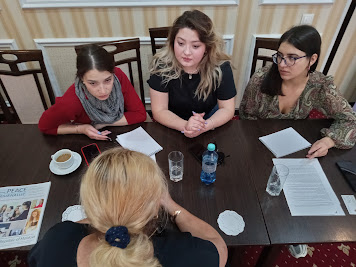 |
| Brainstorming ideas at workshop in Chisinau |
Fulbright Update:
Journalists learn Responsibly Reporting Roma
One of the tenets of peace journalism is to give a voice to the marginalized in our communities. Here in Moldova, and throughout much of Europe, there is probably no group that is as marginalized as Roma.
With this in mind, I launched a two-seminar series on Responsibly Reporting Roma. The
first event was held on May 17 in Chisinau, and the second a week later in
Soroca, a city north of Chisinau with a large Roma population. Both seminars were s
 |
| Elena Sirbu, at Roma workshop in Soroca |
In Chisinau, the panelists and Sirbu all decried the stereotyping and stigmatization of Roma done by the media. Panelist Sergiu Bugai showed several examples where media fed into the stale narrative of Roma as criminals. I said that all journalism codes of ethics I know dictate that journalists not mention the race or ethnicity of subjects in their stories unless it’s relevant. So, the paper should read, “store robbed,” not, “Roma robs store.”
 |
| Panelist Sergiu Bugai at Chisinau workshop |
In both Soroca and Chisinau, I presented some information
about how peace journalism can provide a foundation for more responsibly
reporting about Roma. This includes rejecting stereotyping, xenophobic language
and images like the one Sirbu showed of Roma women in colorful dress. Roma
voices must be central to any reporting about Roma communities. And peace
journalists should offer counternarrative stories that debunk media created and
perpetuated stereotypes, stigma, and myths about Roma. The journalists
attending the seminars were asked to come up with counternarrative story ideas
about Roma in Moldova. The excellent story ideas generated in Chisinau and Soroca
were on religious diversity in Roma communities, discrimination in employment, schooling
for Roma kids, Roma LGBTQ individuals, success stories, Roma women and mental
health, NGO programs for Roma, and mixed families of Roma and other Moldovans.
I hope to see these stories online, in print, and on the air
in the coming weeks.









